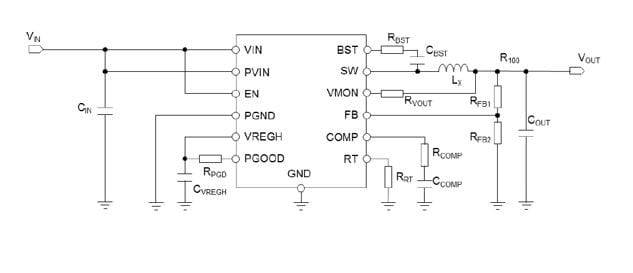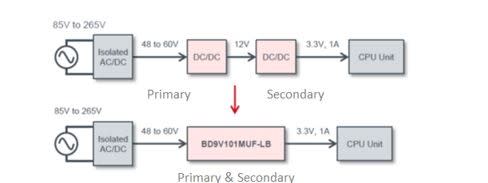Modern hybrid vehicles require modern automotive Buck converters
Follow articleHow do you feel about this article? Help us to provide better content for you.
Thank you! Your feedback has been received.
There was a problem submitting your feedback, please try again later.
What do you think of this article?
Automotive Primary Buck DCDC Converter using Nano Pulse Control™
BD9V100MUF-C (178-5765) is a synchronous Buck primary DCDC converter for automotive applications. It combines low power consumption in a compact form factor and high reliability with functional safety.
The propriety Nano Pulse Control™ which allows a Vin of 60V input to supply Vout 5.5V or less in a single stage with a maximum output current of 1A and an accuracy of +/-2% makes the BD9V100MUF-C so unique.
Generally, the vehicle battery was a Lead-Acid type with a maximum voltage of 42V. Nonetheless, more up-to-date vehicles, particularly hybrids, are utilizing Lithium-Ion batteries where voltages can be up to 60V. This provides benefits in for efficiency and reliability of the vehicle electronics. However, it brings along various problems for existing buck converters. High voltages are additionally utilized in industrial applications where they may be directly supplied from AC-DC converters. A large percentage of the sub-systems or modules, however, require supplies of 5.5V or less, normally 3.3 or 2.5V for instance to supply a CPU. Referring to the first equation below one can say that in a Buck converter the maximum ratio of Vout / Vin is determined by the minimum ON time and switching frequency (fSW).
The Buck converter has to regulate Vout by altering the TON for a set switching frequency. As another option, the Buck converter could regulate Vout by altering the frequency of switching. However, in many applications, this may cause EMI problems.
Equation 1: Relation of Vout to Vin, TON and fSW for a Buck Converter
To prevent interference in the AM radio band, the switching frequency in automotive devices should be lower than 600kHz or at least 2MHz. A higher frequency would decrease the external component size, however, it also decreases the converter's efficiency. 2.2MHz is a popular compromise for the automotive industry. Regrettably, the current Buck converter generation has a minimum Ton of ~30ns, which means that at this frequency they cannot produce 2.5V or 3.3V (usually needed by most sub-systems) straight from a 60V. In this case, it would require both a primary and a secondary DCDC, that is a two-stage solution.
This would increase the cost of the system. The below figure 1 outlines the two alternatives.
Figure 1: Example of two AC to DC power Trees using a Buck Converter
‘Nano Pulse Control™ is used in the BD9V100MUF-C. The IP enables the product to obtain a best-in-class minimum Ton of ~9ns. Moreover, it attains a voltage conversion from 60V to 2.5V or less. This provides price and PCB area reduction.
The Propriety technology employs switching current monitoring together with careful noise reduction techniques. The BD9V100MUF-C is capable of providing an output voltage of 5.5 V or less, with a maximum IOUT of 1A and an accuracy of +/-2%. With a typical Vin of 60V, the application can tolerate up to 70V.
Various safety functions
To ensure the functional safety in any device, the BD9V100MUF-C integrates a range of safety functions to protect the device, especially against external faults.
The Under-Voltage Lockout (UVLO) circuit will stop the BD9V100MUF-C switching if Vin is too low for safe operation. To reduce current consumption during operation without any load(Iq) the BD9V100MUF-C has an enable pin (EN). After activating the enable pin the device re-start with a soft start.
The Short Circuit Protection (SCP) is included to protect against brief external errors such as a short to ground on the load. If the ON time is longer than expected the BD9V100MUF-C will stop switching (output will be high impedance) and then restart.
The Over Current Protection (OCP) circuit detects the lower limit of the inductor current. The integrated high side MOSFET will not turn ON until the current falls below the limit. If OCP is detected multiple times, the BD9V100MUF-C will stop switching for a ~30ms before re-starting
The Over Voltage Lockout (OVLO) disables the BD9V100MUF-C if Vin is too high and recovers when Vin falls. When the voltage falls it will restart with a soft-start.
The Power Good open-drain output will be set to high impedance when the target is reached by the feedback voltage. If it’s out of range, the voltage will be set low. This output can be used as a RESET signal for other applications when using If the feedback voltage is too high, the output MOSFETs will be switched OFF by the Over Voltage Protection (OVP), when the voltage falls, a soft restart will be initialized.
The Thermal Shutdown will disable, in case the junction temperature is too high. The device will recover automatically when the junction temperature falls.
Application
The BD9V100MUF-C is designed for easy integration featuring a minimum BoM to reduce PCB area and costs.
The input and output voltages are buffered by two capacitors (CIN and COUT). The output voltage is set by the external resistive network (RFB1 and RFB2) for flexibility. The switching frequency is temperature independent and set by an external resistor (RRT) for accuracy and there is an external compensation network (RCOMP and CCOMP) to optimize the frequency response. The internal regulation requires a decoupling capacitor (CVREGH) and a boot strap capacitor (CBST). The Bootstrap resistor (RBST) is used to reduce EMI and the pin VMON is protected from the inductive load by a resistor (RVOUT).

ROHM Semiconductor Automotive BD9V100MUF-C DC/DC Buck Converter is available from RS in packs of 2 (178-5765) or reels of 2500 (178-5624)
In order to grow the portfolio of power management IC’s for the automotive market, ROHM developed the BD9V100MUF-C DC/DC Buck Converter. Please visit www.rohm.com for more details.




